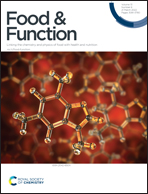Memory enhancement effect of saponins from Eleutherococcus senticosus leaves and blood–brain barrier-permeated saponins profiling using a pseudotargeted monitoring strategy†
Abstract
Dried Eleutherococcus senticosus leaves (ESL), also known as Siberian ginseng tea, are beneficial for human neural disorders. Our previous studies showed that the aqueous extract of ESL enhanced memory in mice, and its saponin fraction (ESL-SAP) exhibited promising neuroprotective activities in vitro; however, the in vivo neurally related effect, bioactive material basis, and possible mechanism of action of ESL-SAP have not been investigated. Here, a series of memory and learning tests were carried out, and the results evidenced a significant enhancement effect of ESL-SAP. Furthermore, an in vivo saponin library-guided pseudotargeted strategy was established to support the rapid monitoring of 26 blood–brain barrier (BBB)-permeated saponins from ESL-SAP-administered rats. A further network pharmacology analysis was conducted on BBB-permeated compounds, which indicated that the in vivo mechanism of ESL-SAP might be effective through multiple targets and pathways, such as the AGE-RAGE signaling pathway and PI3K-Akt signaling pathway, to exert neuroprotective effects. Moreover, the molecular docking experiments demonstrated that key BBB-transferred saponins primarily interacted with targets HRAS, MAPK1, and MAPK8 to produce the neuroprotective effect.



 Please wait while we load your content...
Please wait while we load your content...